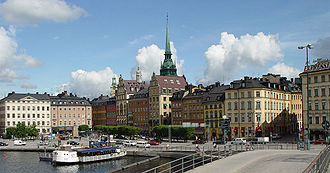Gamla stan
Gamla stan ( Swedish ; actually gamla staden , "the old town ") is the old town of the Swedish capital Stockholm , located on the island of Stadsholmen . It is located in the district of Södermalm . In Gamla Stan there is the castle built by Nicodemus Tessin the Younger as well as the two churches Storkyrkan (Nikolaikirche) and Tyska kyrkan (German Church). In the Storkyrkan is the outstanding medieval equestrian sculpture of St. George fighting the dragon by Bernt Notke , which can also be found in the old town as a bronze work.
Building history
What is now known as Gamla stan was Stockholm proper for many centuries. The current central districts of Norrmalm , Södermalm and Östermalm , on the other hand, had a more rural character. The first houses were built in the 13th century under the protection of the castle, which Birger Jarl had built to monitor the entrance to Lake Mälaren . A town hall was built on the central square, Stortorget , and the village church was built behind it, which later became today's Nikolaikirche . Streets that were laid out in an irregular pattern went from the square to the various city gates. The oldest occupied streets are Köpmangatan (first mentioned in 1323), Skomakargatan (1337) and Svartmangatan (1437).
In the Middle Ages, the town was surrounded by a city wall, which lay above today's streets Västerlånggatan and Österlånggatan . As early as the end of the 13th century, the city began to be built by filling the island's beaches with soil. The city wall was moved and houses built on the newly won area. After a devastating fire of 1625, which mainly destroyed the southwestern parts of the city, extensive compensation work was carried out, resulting in the formation of the straight streets of Stora Nygatan and Lilla Nygatan . At the end of the 17th century, the city walls had lost their importance and were consequently torn down.
The oldest buildings were probably wooden houses, but in the late Middle Ages most were replaced by stone houses. The facades of many medieval buildings were later redesigned. They received high gables and richly decorated portals. In the 18th century the roof shapes of many buildings were changed and the facades were plastered uniformly. In the following century, the houses on the shopping streets were given representative shop windows. Today there is still a large number of medieval masonry behind the visible facades. In the buildings you will often find medieval cellars, lime paintings from the 16th century, ornate ceiling beams from the 17th century, high-class interior fittings in the Rococo style or exuberant decorations from the 19th century.
traffic
The island of Gamla Stan can be easily reached by private and public transport. At the station stan Gamla keep the Grona - and Röda linjen the Stockholm subway . Furthermore, various bus lines drive across the island and have stops there. The island and the Vasabron , Norrbro and Strömbron can be reached by private transport from the direction of Norrmalm . Gamla Stan can be reached from Södermalm via the Slussen transport hub . The Centralbron bridge leads over the island, but has no entry or exit there.
St. George and the Dragon (design by Bernt Notke )
More buildings and monuments on Gamla Stan
- Axel Oxenstierna's palace
- Bondesches Palais
- Riddarhuset
- Ticino palace
- Obelisk at Slottsbacken
- Bågspännaren
- Evert Taube statue
- Lars Johan Hierta memorial
- Olaus Petri monument
- Riddarholmsbroarna
- Sven Vintappares torg
- Sjöguden
- Statue of Gustav III.
- United States Embassy
literature
- Nils-Gustaf Stahre among others: Stockholms gatunamn . In: Stockholmsmonografier . Almqvist & Wiksell, Uppsala 1982, ISBN 91-38-72610-6 , p. 48ff.
Web links
Coordinates: 59 ° 19 ′ 30 ″ N , 18 ° 4 ′ 15 ″ E












